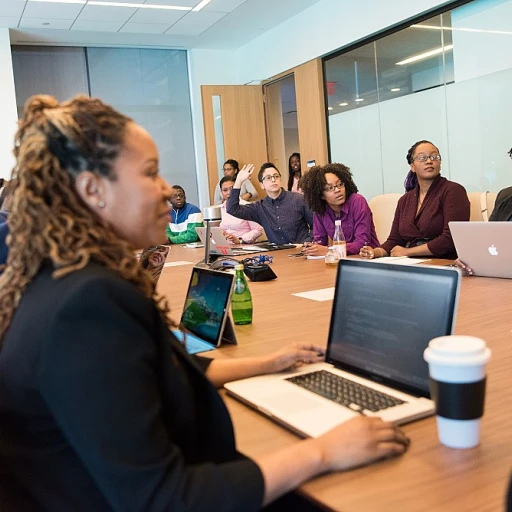Understanding the Profile of a Top Talent
Recognizing Top Talent Traits
Identifying top talent, whether in the context of a company looking to fill a job title or during a significant election cycle such as a presidential race, involves understanding key characteristics that consistently prove to be indicators of success. In the hiring process, this translates to evaluating both a potential candidate's technical skills and soft skills. Experience plays a crucial role but identifying high potential also relies on recognizing attributes beyond just what's listed on a resume.- Skills and Experience: A successful candidate should possess a diverse set of skills and relevant experience that align with the job description or the requirements of the role they are running for. For instance, a mix of technical expertise and leadership skills could be pivotal for a candidate running for governor or a key position within a company.
- Soft Skills and Character: Soft skills such as communication, adaptability, and problem-solving can make a considerable difference in a person's ability to succeed in a dynamic environment. These traits can enhance a candidate's hiring potential, making them suitable not just for a job but for a long-term role in shaping the organization's culture or political landscape.
- Cultural Fit and Potential: A candidate's fit with the company culture or the values of a political party is critical. Beyond the resume, evaluating a potential candidate's alignment with the culture and their potential to grow within the system is essential. In cases like the presidential election or a vice-presidential running mate, this can reflect their ability to lead effectively while resonating with the electorate.
Leveraging Technology in Candidate Sourcing
Harnessing Technological Advancements for Sourcing Success
The modern hiring process has transcended traditional methods, with technology playing a crucial role in sourcing the right candidates. To navigate this digital age effectively, companies must embrace innovative solutions and tools that streamline the recruitment journey and identify high potential individuals.
First, leveraging advanced candidate sourcing platforms is fundamental. These platforms utilize AI and machine learning to process vast amounts of data, allowing recruiters to identify potential candidates based on their skills, experience, and career trajectory. Such technological solutions offer a more profound insight into a candidate's hiring potential, reducing the reliance on conventional methods that might overlook talented individuals.
Create a comprehensive digital approach by integrating social media channels and professional networks. In the era of the presidential election and political campaigns, where votes and public opinion are continually analyzed, businesses can mirror this strategy to understand the preferences and strengths of their candidates. Companies can tap into platforms like LinkedIn to promote job opportunities and highlight their corporate culture, effectively engaging with prospective employees who might not be actively seeking but are ready to make a career shift.
Furthermore, employing sophisticated applicant tracking systems (ATS) ensures a seamless hiring experience for both the company and the candidate. An ATS can enhance the efficiency of managing resumes and applications, guiding recruiters through the evaluation process and supporting the task to match job titles accurately with the required skills and experience levels.
By combining these technological strategies and fostering an inclusive company culture, businesses can attract a diverse range of potential candidates. They can further position themselves as reputable employers in the competitive market. As companies continue to evolve in their approach, a strategic partnership between human touchpoints and digital capabilities will prove invaluable.
In conclusion, understanding and implementing technology is vital for staying competitive in candidate sourcing. Unlock the full potential of your recruitment activities by embracing effective tools and strategies, which can be found in this comprehensive guide to effective candidate sourcing. Through a blend of digital innovation and strategic insight, your organization can secure top talent and drive long-term success.
Building a Strong Employer Brand
Enhancing the Employer Value Proposition
Building a strong employer brand is crucial in today's competitive job market. A compelling employer value proposition can be a magnet for potential candidates, highlighting the unique benefits and values that your company stands for. It conveys why working for your organization is a rewarding experience, beyond just a paycheck. Employer branding has a direct impact on attracting high potential candidates and plays an influential role in the hiring process. A well-crafted employer brand can often be the deciding factor for candidates evaluating job offers. Companies with a robust and positive brand are more likely to receive votes of confidence from job seekers, even if they are currently employed, or what the industry terms as 'passive talent.'Showcasing Company Culture and Values
A strong employer brand effectively communicates your company culture and core values. By making these transparent, candidates can assess early on if they align with your organizational culture and have the soft skills necessary to thrive. In the same way a presidential candidate showcases their manifesto, businesses should clearly project their missions and visions. This is essential for attracting potential candidates whose values are in sync with that of the company. This communication extends into how you present yourself in the hiring market, effectively setting you apart in a crowded field similar to a national convention where each party showcases their running mate. By utilizing online platforms and social media, businesses can provide candidates with insight into daily life at the company and the experiences of current employees, much like the coverage of a presidential race where every move is scrutinized.Consistency in Branding Across Platforms
Just as political campaigns ensure consistent messaging, maintaining a consistent brand voice across various media platforms is essential. Ensuring that the message stays uniform across your website, social media, and job boards reinforces the brand's image and lends credibility to your hiring efforts. Potential candidates are more likely to trust a brand they perceive as coherent and authentic, much like how candidates in an election aim to win the trust of the electoral college. Incorporating feedback from current employees and integrating it into the brand narrative can be likened to an incumbent keeping a finger on the pulse of public opinion. It's about ensuring that the brand narrative is informed and relevant, effectively attracting high potential candidates who resonate with the brand values. Finally, consider crafting strategies that are not just short-term fixes but are part of a long-term talent strategy for effective candidate sourcing. By focusing on building a strong candidate pool now, companies can position themselves to meet future demands with greater agility and success. Crafting a long-term talent strategy for effective candidate sourcing is not just beneficial, it's essential for securing the type of talent that can propel the company forward.Networking and Relationship Building
Strategic Networking for Candidate Sourcing
Networking is an invaluable tool in identifying potential candidates with the right skills and experience for a job. Establishing a broad and diverse network leads to a wealth of candidates that might not be easily visible through traditional channels. Building strong relationships can uncover high potential individuals who may not actively be seeking new opportunities but are open to discussions.
Here are ways to enhance your networking efforts:
- Industry Events: Attend and participate in industry conferences, workshops, and seminars. It’s a perfect ground to identify and engage with professionals displaying the soft skills and expertise your company seeks.
- Online Platforms: Utilize platforms such as LinkedIn to engage with potential candidates, share insights, and participate in professional groups related to your industry.
- Referral Programs: Encourage current employees to refer individuals within their network. Often, they have insights into others' skills and experiences, making this a valuable tool in your recruiting arsenal.
- Alumni Networks: Reaching out to educational institutions’ alumni networks could also yield a pool of qualified candidates ready for new career challenges.
The connection between networking and candidate sourcing is profound. The relationships built can significantly influence the total views on your hiring process and the potential pool of job seekers available. Engaging with a diverse group of professionals also aligns with creating an inclusive hiring process—a key aspect when evaluating candidates for their potential to fit into the company culture.
Diversity and Inclusion in Candidate Sourcing
Promoting Diversity and Fostering Inclusion in the Hiring Process
In today's increasingly globalized world, ensuring diversity and inclusion in the candidate sourcing process is vital to building a dynamic and innovative workforce. Acknowledging and embracing diverse perspectives can lead to enhanced decision-making and a richer organizational culture. Many organizations have realized the importance of integrating diversity into their hiring strategies. Here, we explore effective ways to promote diversity and inclusion:- Broadening Your Search: Start by widening the scope of your candidate searches. Consider tapping into different networks, job boards, and platforms that cater to underrepresented groups. This practice not only increases the pool of potential candidates but also brings a broader array of experiences and skills.
- Focusing on Inclusive Job Descriptions: Craft job descriptions that appeal to diverse groups by using inclusive language. Avoid implying that only certain demographics are suited for the role. Instead, focus on the abilities and skills required, ensuring that potential candidates, regardless of their background, can visualize themselves in the position.
- Implementing Bias-Free Recruitment Practices: Evaluate and refine your hiring process by removing any potential biases. This might include employing blind recruitment techniques, where candidate information that might trigger biases is concealed during initial screening phases.
- Cultivating an Inclusive Workplace Environment: It's crucial to foster a company culture where all employees feel included and valued. Organizations known for their inclusive practices often attract higher numbers of high potential candidates. When a company develops its work environment ensuring fair treatment and equal opportunities, it reflects well on its commitment to diversity.
- Utilizing Employee Resource Groups: Employee resource groups (ERGs) are instrumental in championing diversity and inclusion within a company. They can aid in forming connections with diverse communities and provide insights into creating a more inclusive hiring experience.
Evaluating and Selecting the Right Candidates
Assessing Skills and Experience
When it comes to evaluating candidates, it's crucial to look beyond the resume. While a candidate's experience and job titles provide a foundation, assessing their skills—both technical and soft—is essential. This includes evaluating their potential to grow within the company. A well-rounded evaluation process should consider not just what a candidate has done, but what they can do in the future.
The Importance of Cultural Fit
Company culture plays a significant role in the hiring process. A candidate may have an impressive resume, but if they don't align with the company's values and culture, it could lead to dissatisfaction and high turnover. During the interview process, focus on understanding how a candidate's personal values and work style align with the company's culture. This ensures a more harmonious work environment and increases the chances of a successful hire.
Utilizing Structured Interviews
Structured interviews are a powerful tool in the candidate selection process. By using a consistent set of questions for all candidates, companies can more effectively compare responses and assess each candidate's potential. This method also reduces bias, ensuring a fairer evaluation process. Remember, the goal is to identify high potential candidates who can thrive in the role and contribute to the company's success.
Emphasizing Diversity and Inclusion
Incorporating diversity and inclusion into the hiring process is not just a trend; it's a necessity. A diverse team brings a variety of perspectives, fostering innovation and better decision-making. When evaluating candidates, ensure that the process is inclusive and free from bias. This not only helps in building a diverse workforce but also enhances the company's reputation as an employer of choice.
Making the Final Decision
The final step in the hiring process is often the most challenging. It's important to weigh all factors, including skills, experience, cultural fit, and potential for growth. Engaging multiple stakeholders in the decision-making process can provide different perspectives and lead to a more balanced choice. Ultimately, the goal is to select candidates who will not only excel in their roles but also contribute positively to the company as a whole.







